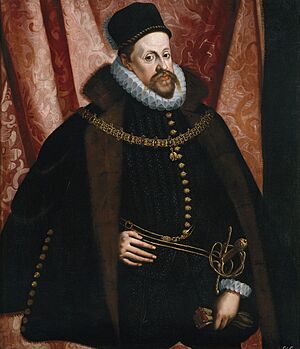Charles II, Archduke of Austria facts for kids
Quick facts for kids Charles II |
|
|---|---|

Portrait of Archduke Charles II, by Bartolomé González y Serrano
|
|
| Archduke of Inner Austria | |
| Reign | 25 July 1564 – 10 July 1590 |
| Predecessor | Ferdinand I |
| Successor | Ferdinand III |
| Born | 3 June 1540 Vienna, Archduchy of Austria |
| Died | 10 July 1590 (aged 50) Graz, Duchy of Styria |
| Burial | Seckau, Austria |
| Spouse |
Maria Anna of Bavaria
(m. 1571) |
| Issue |
|
| House | Habsburg |
| Father | Ferdinand I, Holy Roman Emperor |
| Mother | Anna of Bohemia and Hungary |
| Religion | Catholic Church |
Charles II Francis of Austria (born 3 June 1540, died 10 July 1590) was an important ruler in a part of Austria called Inner Austria. This area included places like Styria, Carniola, Carinthia, and Gorizia. He became the Archduke (a type of powerful duke) in 1564. Charles was part of the famous House of Habsburg family, which ruled many parts of Europe for centuries.
Contents
Life and Rule
Charles was born in Vienna. He was the third son of Ferdinand I, Holy Roman Emperor, and Anne of Bohemia and Hungary. His family was very important in Europe.
For a while, there were talks about Charles marrying Elizabeth I of England. This was in 1559 and again from 1564 to 1568. However, Elizabeth decided not to marry him because he was a Catholic.
In 1563, Charles was also considered as a husband for Mary, Queen of Scots. But Mary and Charles's older brother, Maximilian, did not agree to this marriage.
Unlike his brother, Emperor Maximilian II, Charles was a very religious Catholic. He strongly supported the Counter-Reformation. This was a movement to strengthen the Catholic Church. He even invited the Jesuits, a Catholic religious order, to his lands.
However, Charles also had to be fair to the Protestants in his region. In 1572 and 1578, he made agreements that allowed some tolerance towards Protestantism. This meant Protestants could practice their faith more freely.
Protecting the Land
The region Charles ruled had to deal with many wars. These were mainly against the Ottoman Empire. To help protect his lands, Charles founded a fortress in 1579. This fortress was in Croatia and was named Karlovac after him. It was built to defend against Ottoman attacks.
Supporting Arts and Learning
Charles was also known for supporting arts and sciences. He loved music and helped famous composers. One of his favorites was Orlando di Lasso. He also supported music theorists like Lodovico Zacconi.
Charles cared a lot about education. In 1573, he founded the Akademisches Gymnasium in Graz. This is the oldest secondary school in Styria.
He also had a passion for horses. In 1580, Charles started a special horse farm in Lipica, Slovenia. He brought Andalusian horses there. This led to the creation of the famous Lipizzan horse breed.
In 1585, Charles founded the University of Graz. Today, this university is named Karl-Franzens-Universität after him.
Family Life
On 26 August 1571, Charles married his niece, Maria Anna of Bavaria. They were married in Vienna. They had 15 children together. Twelve of their children lived to be adults.
Some of their notable children include:
- Anna: She became the Queen of Poland and Sweden.
- Ferdinand: He later became the Holy Roman Emperor.
- Margaret: She became the Queen of Spain.
- Leopold: He became an Archduke and Count of Tirol.
- Constance: She also became the Queen of Poland, marrying her older sister's widower.
- Maria Magdalena: She became the Grand Duchess of Tuscany.
Death and Burial
Charles II Francis died in Graz in 1590. His mausoleum, which is his burial place, is in Seckau Abbey. Many other members of the Habsburg family are also buried there. The mausoleum is a very important example of early Baroque architecture. It was started in 1587 and finished in 1612.
Images for kids
See also
 In Spanish: Carlos II de Estiria para niños
In Spanish: Carlos II de Estiria para niños



